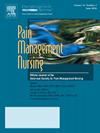使用阿片类药物决策测量的开发与验证。
IF 1.6
4区 医学
Q2 NURSING
引用次数: 0
摘要
背景:每年有数百万人的急性疼痛得不到适当的控制。阿片类药物是控制疼痛的重要工具;然而,最近阿片类药物处方量的减少加剧了疼痛管理方面原有的挑战。此外,患者对疼痛治疗的期望和愿望可能会促使更多的人使用阿片类药物。我们亟需了解患者使用阿片类药物的动机,以便制定有前景的干预措施。本研究旨在开发使用阿片类药物的决定(DTO)测量方法:方法:我们采用探索性顺序混合方法设计来创建 DTO 测量项目。来自患者访谈和焦点小组的定性数据为 DTO 项目的开发提供了依据。我们使用内容效度指数(CVI)和概念意义与九位专家一起评估了候选项目的内容效度。通过与五名急诊科(ED)经历过急性疼痛的参与者进行认知访谈,对表面效度进行了评估:结果:我们初步确定了 52 个项目。专家评分证明了 40 个项目的内容有效性,项目 CVI 得分为 0.83 或更高。9 个项目的 CVI 得分为结论:本研究提供了针对急诊室患者的 DTO 测量的内容效度和表面效度证据。需要进一步进行心理测量学评估,以收集有关 DTO 内部一致性、结构效度和标准效度的数据。本文章由计算机程序翻译,如有差异,请以英文原文为准。
Development and Validation of the Decisions to use Opioids Measure
Background
Millions experience inadequately managed acute pain each year. Opioids are an important tool for managing pain; however, recent reductions in opioid prescriptions have exacerbated preexisting challenges in pain management. Moreover, patient expectations and desires for pain management may drive additional opioid use. There is an important need to characterize patient motivations for using opioids in order to develop promising interventions. The aim of this study was to develop the Decisions To use Opioids (DTO) measure.
Methods
We used an exploratory sequential mixed methods design to create items for the DTO measure. Qualitative data from patient interviews and focus groups informed the development of items for the DTO. We evaluated the content validity of candidate items with nine experts using the content validity index (CVI) and conceptual significance. Face validity was assessed via cognitive interviews with five emergency department (ED) participants who experienced acute pain.
Results
We generated an initial pool of 52 items. Expert ratings provided evidence of content validity on 40 items, as indicated by an item CVI score of 0.83 or higher. Nine items with CVI scores of <0.83 were retained and revised due to the conceptual significance. The remaining three items were discarded.
Conclusions
This study provided evidence of content and face validity of the DTO measure for ED patients. Further psychometric evaluation is needed to gather data regarding the DTO's internal consistency, construct validity, and criterion validity.
求助全文
通过发布文献求助,成功后即可免费获取论文全文。
去求助
来源期刊

Pain Management Nursing
医学-护理
CiteScore
3.00
自引率
5.90%
发文量
187
审稿时长
>12 weeks
期刊介绍:
This peer-reviewed journal offers a unique focus on the realm of pain management as it applies to nursing. Original and review articles from experts in the field offer key insights in the areas of clinical practice, advocacy, education, administration, and research. Additional features include practice guidelines and pharmacology updates.
 求助内容:
求助内容: 应助结果提醒方式:
应助结果提醒方式:


